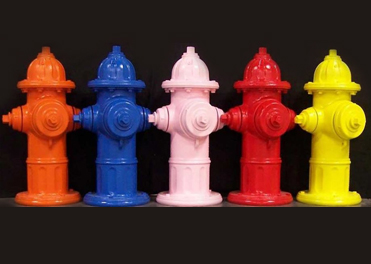Fire Hydrant | Types | Working | Components and Color Coding

When a fire breaks out, every second counts. The immediate availability of water can be the defining factor between a minor incident and a catastrophic event. This is where fire hydrants and their associated systems come into play. But what exactly is a fire hydrant? How does the broader fire hydrant system function? These bright-colored fixtures that punctuate our city streets and neighborhoods play a pivotal role in fire safety, yet many of us are unaware of their intricacies.
In this guide, we will delve deep into the world of fire hydrants, shedding light on their operation, components, color coding, and the critical standards governing their use. Additionally, we’ll walk you through the comprehensive installation process of a fire hydrant system.
Whether you’re a safety professional, a curious homeowner, or just someone keen on understanding community safety tools, this blog promises a thorough understanding of the fire hydrant ecosystem. Let’s dive in!
What is a Fire Hydrant?
A fire hydrant is a connection point by which firefighters can tap into a water supply. It is a component of active fire protection. Functionally, it is a robust vertical pipe that can be accessed above ground with one or multiple nozzles that allow fire hoses to be connected. This setup provides a readily available source of water to combat a potential fire, often supplementing the water supply available in fire trucks.
The placement of fire hydrants is strategic, ensuring that they are readily accessible in the event of a fire while also being widespread enough to serve various locations. They are typically connected to large-diameter water mains to provide sufficient water flow and pressure. When a fire occurs, firefighters connect hoses to these hydrants, which then deliver water under pressure to the area where it’s needed to suppress the fire.
What is a Fire Hydrant System?
A Fire Hydrant System is an active fire protection measure that provides a ready source of water to combat potential fires. It is composed of a series of components that ensure an adequate amount of water is available with suitable pressure and flow, making it accessible for firefighting purposes. The system is usually interconnected with a network of pipes that directly link to the main water supply. This network distributes water to multiple hydrant outlets situated strategically throughout a facility or area.
The essential components of a fire hydrant system typically include the water supply source (which can be tanks, dams, or mains), pipework and valves (that regulate and direct the flow of water), booster pumps (to ensure adequate pressure, if needed), and hydrant outlets (where firefighters can connect hoses to draw water). The system aids firefighters in accessing and directing large volumes of water to a fire, enhancing their ability to suppress it effectively.
The Fire Hydrant System holds paramount importance in the realm of fire safety for several reasons:
- Immediate Access to Water: In the event of a fire, every second counts. A fire hydrant system ensures that a substantial amount of water is readily available to extinguish flames, preventing them from spreading rapidly.
- Adequate Pressure and Flow: Unlike relying solely on traditional sources of water, the hydrant system is designed to provide water at the necessary pressure and flow rate, making firefighting operations more effective and efficient.
- Coverage for Large Facilities: In expansive facilities like factories, warehouses, and multi-story buildings, fires can erupt in remote areas where immediate access to water might be limited. A well-distributed hydrant system ensures that no spot is left vulnerable.
- Supplement to Other Fire Systems: While sprinkler systems and fire extinguishers are essential, they might not be adequate for large fires. A hydrant system complements these systems, providing an additional line of defense.
- Enhanced Safety for Firefighters: Firefighters can tap into the hydrant system to refill their fire trucks, reducing the need to shuttle water back and forth from distant sources. This accessibility can be life-saving, ensuring that firefighters can persistently battle the blaze without interruption.
- Economic Safeguard: Beyond the obvious safety benefits, having an effective fire hydrant system can prevent immense property damage, saving businesses and municipalities potentially millions in damages and insurance claims.
- Compliance with Regulations: Many jurisdictions require the installation of fire hydrant systems as part of their building and safety codes, ensuring that structures are equipped to handle emergencies.
- Community Safety: Hydrant systems, especially in urban areas, serve not only individual buildings but also the surrounding community. A readily available water source can be crucial in preventing fires from spreading to nearby structures or areas.
- Enhanced Preparedness: Fire emergencies are unpredictable. Having a fire hydrant system in place symbolizes proactive preparedness, ensuring that in the direst circumstances, the necessary infrastructure is in place to respond effectively.
In essence, the Fire Hydrant System is a cornerstone of fire safety infrastructure, providing a robust and dependable means to combat large-scale fires, protect property, and save lives.
How do Fire Hydrants Work?
Fire hydrants are ingenious devices that provide quick access to a large volume of water, specifically for firefighting operations. Here’s how they work:
- Water Source Connection: Fire hydrants are typically connected to a city’s main water supply system or a dedicated fire water supply system. This connection ensures that there’s a continuous source of water available when needed.
- Valve Mechanism: Inside the hydrant, there’s a main valve that remains closed until the hydrant is activated. This valve typically sits several feet below the ground to avoid freezing in colder climates (called a “dry-barrel” hydrant). In warmer climates, the water may be present right up to the hydrant head, known as a “wet-barrel” hydrant.
- Activation: To access the water, firefighters or other authorized personnel will connect a hose to one of the hydrant’s nozzles and then open the hydrant using a hydrant wrench. This action turns a stem inside the hydrant, which opens the main valve.
- Water Flow: Once the main valve is opened, water from the underground supply rushes up the vertical pipe in the hydrant and out through the connected hose. The water’s pressure is typically strong enough to combat fires but can be further amplified using pumps on a fire truck if necessary.
- Pressure Regulation: The design of the hydrant allows firefighters to control the pressure and volume of the water by adjusting the valve. Opening the valve fully maximizes the flow, while partially opening it provides a lower flow.
- Shutoff: After the firefighting operation, the hydrant is closed by turning the stem back to its original position using the hydrant wrench. For dry-barrel hydrants, any remaining water in the vertical pipe will drain out through small weep holes at the base to prevent freezing.
- Maintenance: Regular inspections and maintenance are crucial to ensure the hydrants remain operable. This can include checking for leaks, ensuring easy access (removing obstructions or accumulated snow), and occasional pressure tests and flushing to ensure good water flow and to clear any sediment.
In summary, fire hydrants work by providing a direct gateway to a vast water supply. Their simple yet effective design allows for rapid deployment in emergencies, ensuring firefighters have the water volume and pressure needed to tackle fires.
Types of Fire Hydrants
Fire hydrants are designed to suit different environments, needs, and climatic conditions. Here are the main types of fire hydrants:
1. Dry Barrel Hydrants
Designed primarily for colder climates, dry barrel hydrants feature a valve located well below the frost line, the depth in the ground to which freezing temperatures typically extend. By positioning the valve in this manner, water does not stay in the top part of the hydrant, preventing any possibility of it freezing, which could impair functionality or damage the equipment.
When a fire emergency occurs and the hydrant is activated, water from this underground location is channeled upward into the hydrant and directed outward through a connected hose, ensuring a reliable flow even in the coldest conditions.
2. Wet Barrel Hydrants
Primarily found in regions with milder climates where freezing is not a typical concern, these hydrants are always filled with water up to the outlets. A distinguishing feature of the wet barrel hydrant is that each outlet is equipped with its own individual valve.
This setup allows fire personnel to make multiple hose connections at once and control the flow from each independently, offering versatility in firefighting operations.
3. Wall Hydrants
Specifically designed for unique placement requirements, wall hydrants are mounted directly into the walls of structures, making them ideal for locations like industrial complexes or airport runways.
Though their design bears similarities to the dry barrel hydrants, their placement in walls often corresponds to specific firefighting strategies tailored to the buildings they are in, ensuring quicker response during emergencies.
4. Standpipe
Found within the confines of larger edifices, especially high-rise buildings, standpipes serve as an essential tool for firefighting operations. They are extensive piping systems running vertically through the building, equipped with hose connections at specified intervals.
This design eliminates the need for firefighters to haul hoses from the ground floor, allowing them to tap into the building’s water supply at various floors, optimizing fire suppression efforts.
5. Flush Hydrants
Lacking the familiar protruding “barrels” we associate with hydrants, flush hydrants are level with the ground. Their primary role is in water system maintenance and testing. They offer a means to evaluate water flow and pressure in newly established or repaired water mains. Furthermore, their design allows for a high-powered expulsion of water, which is useful in purging the system of sediments and ensuring water quality.
6. Post Indicator Hydrants
These specialized hydrants come with an added feature: a visual post that clearly indicates whether the valve is in an open or closed state. Often, they are connected to specific fire protection systems, like sprinkler systems in commercial establishments. The post serves as a quick reference for fire personnel, ensuring that the system is active when needed.
7. Recessed Hydrants
Prioritizing pedestrian movement and aesthetics, these hydrants are integrated into sidewalks, especially in areas with significant foot traffic or where space is at a premium. They are covered by a plate flush with the ground, which can be removed to access the hydrant. This design ensures that the hydrant is both accessible for fire emergencies and unobtrusive during everyday activities.
8. Pillar Hydrants
A common sight in various European regions, pillar hydrants stand tall, with their control mechanisms easily accessible at a convenient height. Beyond their functional benefits, they often sport a distinctive design, making them easily identifiable. Their vertical structure ensures that connections and controls are elevated, keeping them clear from ground-level obstructions and potential damage.
Each type of hydrant is designed with a specific purpose and environment in mind. Proper selection ensures that water can be readily accessed when needed, especially during emergencies. Regular maintenance and testing are vital to keep all hydrants in working order.
Different Components of Fire Hydrant System
A fire hydrant system is an intricate arrangement of components designed to provide water in ample quantities for firefighting operations. Here’s a detailed breakdown of the different components that typically constitute a fire hydrant system:
- Fire Hydrants: These are the most visible parts of the system, providing an external connection point for firefighters to tap into the water supply. They can be of various types, as discussed previously, like dry barrels, wet barrels, and pillar hydrants.
- Water Supply Source: This is the primary reservoir or source from which the hydrant system draws its water. It could be a dedicated water tank, a natural water source like a lake or river, or connected directly to the municipal water supply.
- Pumping System: To ensure that water reaches the hydrants with adequate pressure, a pumping system is employed. This typically comprises one or more high-capacity pumps that can drive water swiftly through the system, especially over long distances or to significant heights in high-rise buildings.
- Distribution Pipework: This consists of a network of underground or above-ground pipes that transport water from the source to various hydrants. These pipes need to be durable and resistant to corrosion and other environmental factors.
- Valves: Valves are crucial components that regulate the flow of water within the system. They can be used to isolate sections of the network for maintenance or to control water flow during firefighting operations. Gate valves and butterfly valves are commonly used in hydrant systems.
- Hose Reels and Hoses: Often found alongside hydrants, hose reels provide firefighters with easy access to hoses. These hoses are specifically designed to be durable, flexible, and capable of withstanding high pressures.
- Fire Brigade Inlets (or Collecting Heads): These are connection points that allow firefighters to pump water into the system from their fire trucks, supplementing the existing water supply, especially if it’s inadequate during a major fire.
- Pressure Gauges: These are instruments that monitor the pressure within the system, ensuring it remains within safe and operational limits. Regular monitoring can alert operators to potential issues or blockages.
- Post Indicator Valve (PIV): This component provides a visual indication of whether a valve is open or closed. It’s especially useful in systems connected to automatic fire sprinkler systems in buildings.
- Drain Points: These are strategically placed points within the system that allow for drainage of water, especially important for maintenance, testing, or preventing freeze in cold climates.
- Risers: In multi-story buildings, risers are vertical pipes designed to transport water upwards. They might also include landing valves on various floors to provide connection points for hoses.
Each of these components plays a crucial role in ensuring the overall efficiency and reliability of the fire hydrant system. Regular inspection and maintenance are essential to keep each part in optimal working condition and guarantee the system’s readiness in case of emergencies.
Fire Hydrants Color Coding
The color coding of fire hydrants provides important information about the water supply’s flow rate and pressure. It helps firefighters make quick decisions about which hydrants to use, especially in emergencies. Color coding can vary by country and even within regions of the same country. Still, the following is a general overview based on the National Fire Protection Association (NFPA) standards used in many parts of the U.S.:
- Red: This typically indicates a fire hydrant with a water flow of less than 500 gallons per minute (GPM). It’s considered appropriate for basic residential areas but might not be suitable for commercial or industrial firefighting needs.
- Orange: An orange hydrant signifies a flow rate of 500 to 999 GPM. This is a moderate flow rate and can be used for many firefighting operations.
- Green: Green hydrants indicate a flow rate of 1000 to 1499 GPM. These hydrants are suitable for most firefighting needs, including many commercial areas.
- Blue: Blue signifies the highest flow rate, typically 1500 GPM or more. These hydrants provide a robust water supply, suitable for large fires or industrial areas.
- Caps and Bonnets: Apart from the main body, hydrants’ caps and bonnets can also be color-coded. They might offer additional information about the hydrant’s specific characteristics or indicate different sources of water, such as non-potable water sources.
- Other Colors: In some areas, yellow or white might be used as a base color for hydrants, with the caps being painted in one of the standard colors to indicate flow rate. Sometimes, other colors are employed for special purposes. For example, a purple hydrant might indicate that the water source is non-potable or reclaimed.
- Reflective Markers: Some jurisdictions also use reflective markers or bands to make hydrants more visible at night, enhancing safety and accessibility for firefighters.
Local fire departments and water authorities must maintain a consistent color-coding system and ensure that all relevant personnel are trained to recognize and understand the significance of the colors. Additionally, residents and businesses should be educated not to repaint hydrants without authorization, as altering their colors can mislead firefighters during emergencies.
Codes And Standards Of Fire Hydrants
Fire hydrants and their associated systems are governed by a variety of codes and standards to ensure their reliable performance during emergencies. These codes and standards specify requirements related to design, installation, testing, and maintenance. Recognized organizations establish them to ensure that fire hydrants function as intended and provide firefighters with the necessary water supply.
National Fire Protection Association (NFPA)
- NFPA 24: Titled “Standard for the Installation of Private Fire Service Mains and Their Appurtenances”, this standard provides details on the installation of fire service main piping, private hydrants, and more.
- NFPA 291: Called “Recommended Practice for Fire Flow Testing and Marking of Hydrants”, this provides guidance on fire flow tests and the color-coding of hydrants to indicate their flow capabilities.
- American Water Works Association (AWWA)
- AWWA C502: This standard, titled “Dry-Barrel Fire Hydrants”, establishes minimum requirements for dry-barrel fire hydrants used in water supply service.
- AWWA C550: Pertaining to protective epoxy interior coatings for valves and hydrants, this standard ensures longevity and safety.
- International Building Code (IBC): This is a comprehensive building code used internationally, which includes provisions related to fire hydrants, their placement, and other relevant aspects related to fire protection.
International Fire Code (IFC)
This code covers general fire prevention regulations and fire protection requirements for new and existing buildings, facilities, storage, and operations, including specifics about hydrants.
Local and State Codes
In addition to international and national standards, individual states or local municipalities may have additional requirements or modifications for fire hydrant systems. These might pertain to factors like minimum distances between hydrants, required flow rates based on the types of structures in an area, or specific maintenance practices.
Factory Mutual (FM) Global
FM is a major insurer of commercial and industrial properties worldwide and has its own set of standards related to fire hydrants, which might be required to secure property insurance.
Underwriters Laboratories (UL)
UL is an organization that tests and certifies products for safety. Fire hydrants that have been tested and certified by UL have met specific safety and performance standards.
ISO (Insurance Services Office)
ISO evaluates municipal fire-protection efforts in communities throughout the United States, and one of their criteria is the distribution, functionality, and maintenance of fire hydrants. Their evaluation can influence local property insurance rates.
Designers, contractors, and local authorities must be aware of and compliant with all relevant codes and standards when installing, maintaining, or evaluating fire hydrants. Regular reviews and updates of these standards are also essential to incorporate new research findings, technological advancements, and lessons learned from fire incidents.
Installation Of Fire Hydrant System
Installing a fire hydrant system involves a series of detailed steps to ensure its effective functionality during emergencies. A comprehensive fire hydrant system not only includes the hydrants themselves but also the network of water supply pipes, valves, and other associated components. Here’s a general outline of the installation process:
1. Site Survey and Planning
- • Before any installation begins, a thorough site survey is crucial. This helps in understanding the topography, identifying potential obstacles, and determining the optimal locations for hydrants based on building access, roadways, and other factors.
- • The flow requirements, based on the types of buildings and risks in the area, need to be determined at this stage.
2. Design and Blueprint
- • Once the initial survey is complete, a detailed design and blueprint of the system are created. This includes the location of each hydrant, the size, and layout of water mains, valves, and other infrastructure.
- • The design will also take into account any future expansions or modifications that might be necessary.
3. Excavation and Groundwork
- • Trenches are dug for the water main pipelines. The depth and width of the trenches are based on local codes and the size of the pipes. In colder climates, pipes are buried below the frost line to prevent freezing.
- • Locations for the hydrants are prepared, ensuring stable ground for mounting.
4. Laying the Pipelines
- • Water mains, typically made of ductile iron, PVC, or other suitable materials, are laid in the trenches.
- • Proper care is taken to ensure the pipes are level, and they are then connected using appropriate fittings.
5. Hydrant Installation
- • At predetermined locations, vertical pipes are connected to the water main to mount the hydrants.
- • The hydrants are then secured, ensuring they are upright and stable.
6. Valve Installation
- • Valves are installed at key points in the system, allowing for sections of the network to be isolated for maintenance or in case of damage. Gate valves are commonly used for this purpose.
7. Backfilling and Surface Restoration
- • Once the pipelines and hydrants are in place, the trenches are backfilled, ensuring the soil is compacted to avoid future settling.
- • Roads, sidewalks, and other surfaces are then restored.
8. Testing and Commissioning
- • Before the system is operational, it undergoes a series of tests. These include pressure tests to ensure there are no leaks and flow tests to verify the system can deliver the required amount of water.
- • Any issues identified during testing are addressed.
9. Marking and Color Coding
- • Hydrants are often color-coded based on their flow capacity, as per local or international standards.
- • Other markings or signage might be added to indicate the location of underground valves or to provide additional information for firefighters.
10. Maintenance Plan
- • After installation, a regular maintenance schedule should be established. This includes periodic inspections, testing, and servicing to ensure the system remains in optimal working condition.
- • Remember, local codes and standards may vary, so it’s essential to be aware of and compliant with all relevant requirements during the installation process.
Conclusion
Fire hydrants, often unnoticed on our daily commutes, are silent sentinels of safety, standing guard, and ready to serve in times of emergency. Their importance goes beyond the vibrant colors they sport; they represent a complex, well-thought-out system that is vital for safeguarding properties and lives against the destructive force of fires.
By understanding the intricate details of a fire hydrant system, from its basic components to the standards that govern its operation, we gain a renewed appreciation for the extensive planning and infrastructure dedicated to public safety.
Moreover, as communities continue to grow and urbanize, ensuring the correct installation and maintenance of these systems becomes paramount. In conclusion, fire hydrants are not just metal fixtures; they are a testament to human ingenuity and our collective commitment to protecting lives.
- (This "Fire Safety Blogs" Published in April 2024 Edition)












